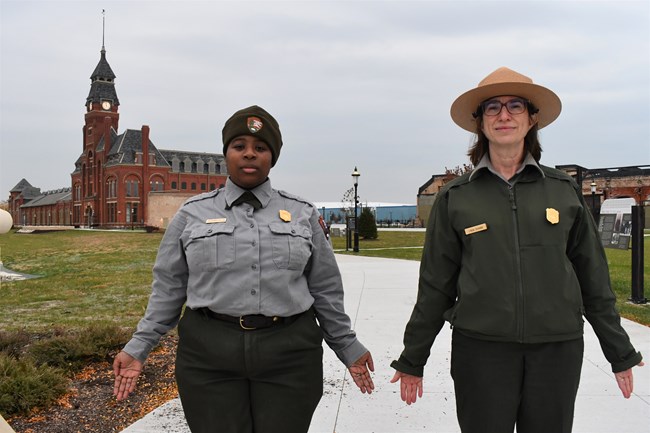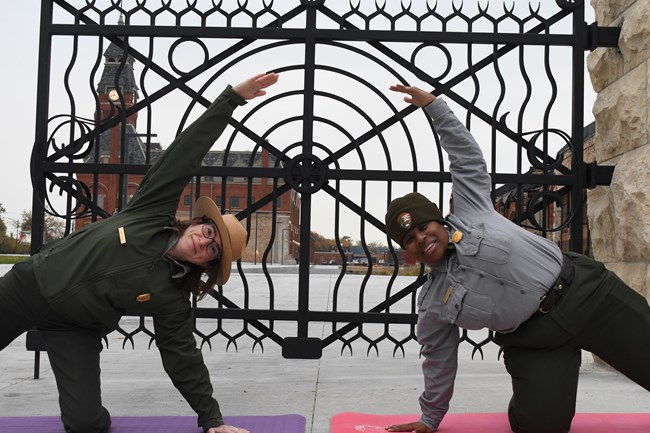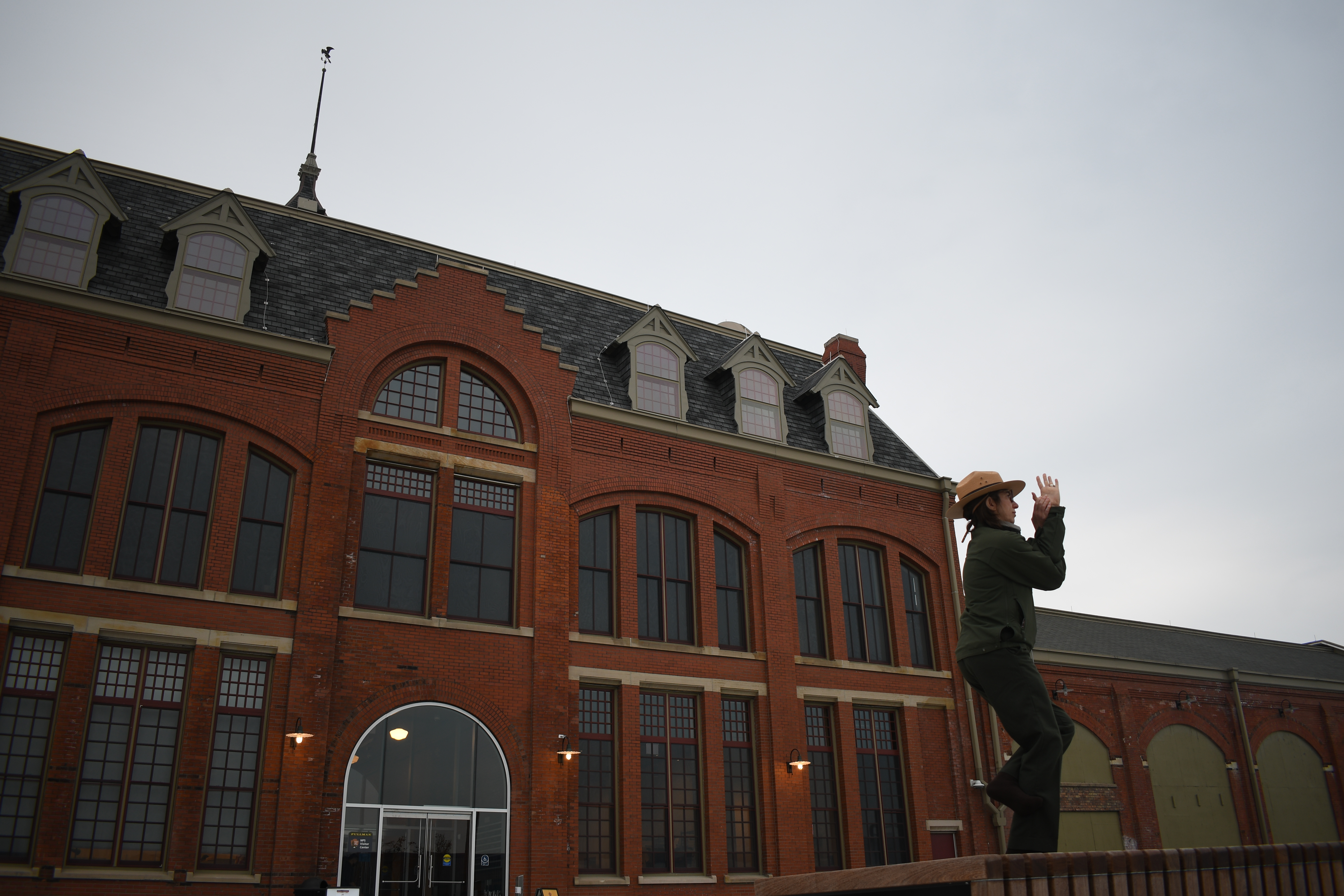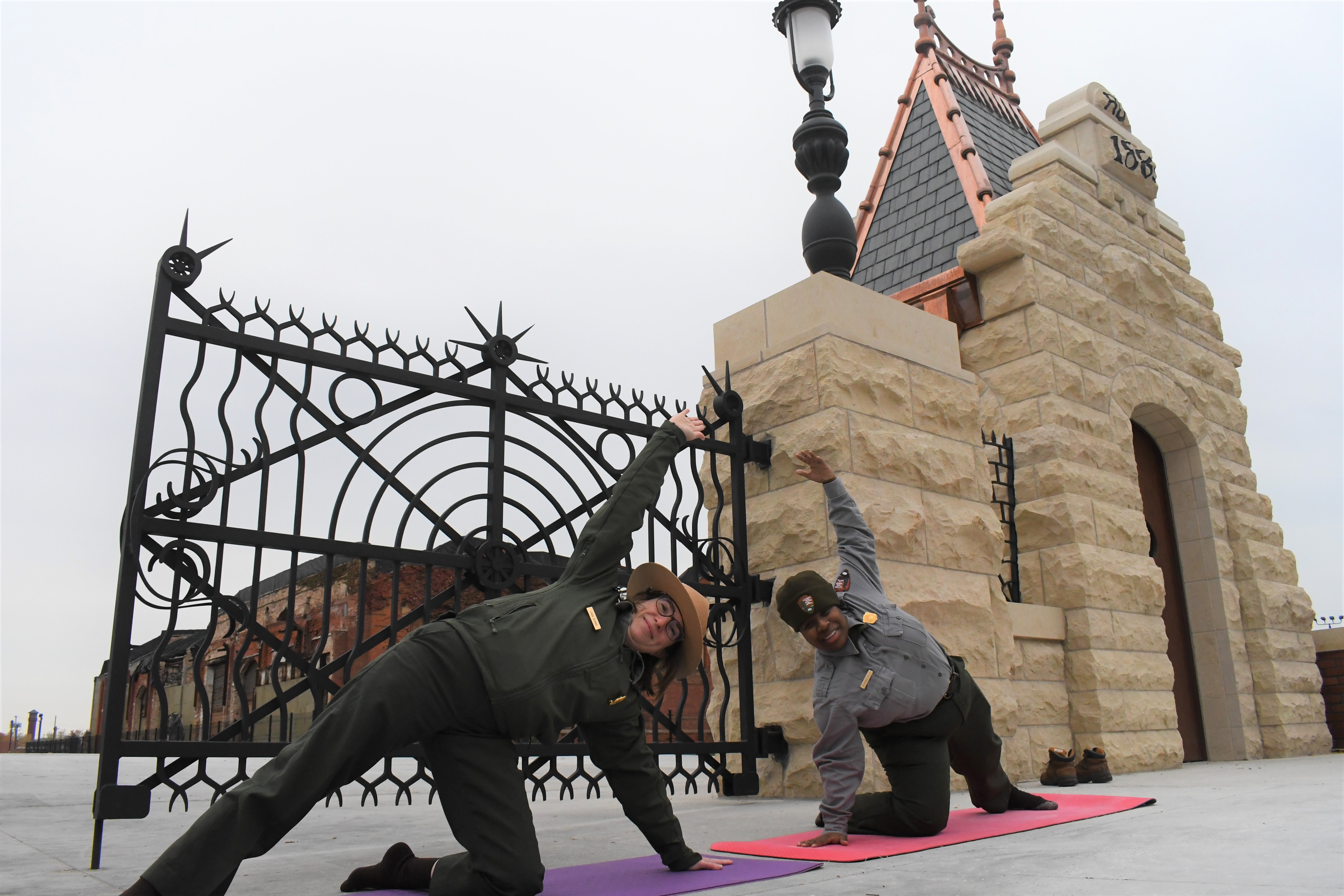Last updated: April 24, 2023
Article
Pullman Yoga
This can be done at home virutally, outside in your backyard or favorite park, or in the classroom for a quick "historic" stretch break!

NPS Photo/Owen Miller-Dye
Clock Tower (Mountain) Pose
- Stand with the feet parallel, a few inches apart. (Alternately you may stand with the bases of your big toes touching, heels slightly apart). Lift and spread your toes and the balls of your feet, then lay them softly back down on the floor.
- Lift the top of your sternum straight toward the ceiling. Widen your collarbones. Shrug your shoulders up to your ears and then roll them back to release your shoulder blades down your back.
- Let your arms hang naturally, relaxed beside your torso, palms facing in or forward.
- Let your neck be long, your chin neither tucked down nor lifted up, as the crown of your head rises toward the sky.
- Take 5 to 10 breaths while you hold yourself in this position.
Built in 1880, the Administration-Clock Tower Building formed the central mass of a monumental structure seven hundred feet long. As the manufacturing center of Pullman, the Administration and Factory Complex was an unusually ornate industrial building designed to sit in a park-like setting. Stand tall and strong like the Clock Tower.

NPS Photo/Owen Miller-Dye
Eagle Pose
- Bend your knees. Balance on your right foot and cross your left thigh over your right. Fix your gaze at a point in front of you.
- Hook the top of your left foot behind your right calf.
- Extend your arms straight in front of your body. Drop your left arm under your right.
- Bend your elbows, and then raise your forearms perpendicular to the floor. Wrap your arms and hands, and press your palms together (or as close as you can get them).
- Lift your elbows and reach your fingertips toward the sky. If your palms don't touch yet, press the backs of your hands together, instead.
- Keep your shoulder blades pressing down your back, toward your waist. Square your hips and chest forward. Draw your belly in and up.
- Gaze at the tips of your thumbs. Breathe smoothly and evenly, keeping your gaze fixed and breathing soft, holding as long as you like. Unwind, and try the opposite side!
The Pullman Administrative Clock Tower features a weathervane with an eagle perched atop. Channel your eagle pose and imagine soaring above Pullman’s beautiful landscape.

NPS Photo/Owen Miller-Dye
Tree Pose
- Shift your weight slightly to one foot, and place your other foot on your ankle, calf, or thigh (but never on your knee).
- Place hands together in front of your chest or raise your hands in the air, arms outstretched like the branches of a tree. Try the opposite side!
Pullman’s residential streets were originally and intentionally tree-lined as a beautiful element of the cityscape. Stroll the streets of the neighborhood and discover the urban beauty.

NPS Photo/Owen Miller-Dye
Painter (Chair) Pose
- Begin in Clock Tower pose.
- Exhale as you bend your knees and move your hips back as if you were sitting down on a chair. Draw your lower abdomen in and up to support your lower back.
- Send your hips back rather than your knees forward, so that you can still see your toes.
- Inhale as you raise your arms up around your ears and soften your shoulders.
- Keep reaching higher, while sitting lower for 5 to 10 breaths.
- To come back into Clock Tower, exhale, as you press your feet down to straighten your legs and then bring your arms down to your sides.
The Pullman Palace Car Company employed master craftsmen, including skilled painters to finish the luxurious interiors and impressive exteriors of the Pullman dining, sleeping, and parlor cars. This depiction of a painter at work is on display at our Visitor Center in the Clock Tower Administration building.

NPS Photo/Owen Miller-Dye
Gate Pose
- Kneel on the ground, hands on hips.
- Extend your right leg to the side, so that your right foot is in line with your left knee. Remain facing forward.
- Place your right hand on your right shin or ankle.
- Sweep your left arm upwards and bend over to the right, sliding your hand down along your right leg. Keep torso facing forward, and left knee aligned under left hip. Feel the stretch in your left side and the balance in your core. Try the opposite side!
The Workers’ Gate at Pullman National Historical Park was the scene of a united Pullman manufacturing worker’s walk-out and strike in 1894. This walk-out led to the largest national labor protest in the 19th century. The current limestone guardhouse and iron gate are faithful reconstructions of those installed circa 1886.

NPS Photo/Owen Miller-Dye
Brick (Rock) Pose
- Start on your hands and knees. Sit back on your heels.
- Bring your big toes together and separate your knees a little wider than your hips.
- Lean forward, resting your forehead on the mat and lay your arms palms up comfortably on the sides of your thighs.
- As you breathe, focus on relaxing the muscles of the spine and lower back.

NPS Photo/Owen Miller-Dye
Sleeping Car (Savasana) Pose
- Lay on your back with straight legs, allowing your legs to fall open to either side.
- Relax your arms to the sides away from your body with palms facing upward.
- Shoulders are tucked into the mat.
- Relax into the pose and release any effort of holding on to the position. Let your face relax and allow your body to sink into the mat.
- Breath naturally for about 5 minutes. Bring your thoughts back to your mat if your mind starts to wonder.
- Come out of this pose slowly by wiggling your fingers and toes to awaken your body. Reach overhead and pull your knees into your chest. Roll over to one side and come into a sitting position.
The Pullman Palace Car Company was established by George M. Pullman in 1867. At the core of the business was the manufacture and operation of luxurious sleeping cars, staffed by African American Pullman Porters. The Pullman cars set the high standard for luxury and service on American rails. The Pullman sleeping cars featured an upper sleeping berth which pulled down for extra accommodations.



